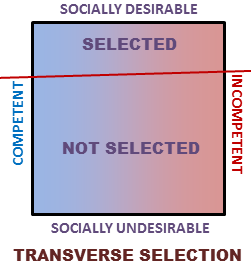I once worked for a government office admin professional, one of the most powerful GS employees in his agency at the time, who boasted about rejecting a well-qualified candidate for a computer programming position because the guy had worn white socks with dress pants and dress shoes.
We see interview advice all the time targeting the interviewee, advice on grooming and speech and how to compose and format a résumé. “Five Huge Mistakes You Should Avoid During an Interview” is a web headline sure to go viral.
We don’t often see advice for interviewers and hiring officials steering them away from mistakes, however. We seem to simply assume they’ll do the right thing. They’re trained professionals, after all.
This is a dumb assumption.
When I asked the admin “pro” how the candidate he actually hired turned out, he boasted again, this time that the guy wrote a key piece of organizational software almost single-handedly. When I clarified that this was the same software that was frequently offline, universally despised, and perennial a target for replacement, he shrugged it off.
“Every program has its bugs!”
Admin processes also have their bugs, and this interviewer had stumbled upon one of them, to great cost to his organization. Since it doesn’t have a common name, we at NewGovOffice have dubbed it transverse selection.
The term transverse selection has a prior meaning in physics, but in organizational theory it means making decisions, particularly in hiring and promotion, based on criteria that are not directly related to the practical needs of the job.
Transverse selection encompasses a variety of bad decision processes, from fashion show absurdities like the anecdote above to all forms of racial, sexual, and other discrimination—including practices intended to compensate for discrimination by flipping the selection bias. Less overtly, transverse selection arises from subtle problems like social comparison bias and a range of bizarre cognitive biases related to height, baldness, and clothing color, i.e. the Power Tie Syndrome.

The line drawn for selection lies transverse to the gradient between competence and incompetence. Obviously, the proper way to draw that line would be up-and-down, perpendicular to transverse selection, separating competent decisions from incompetent ones without regard to social biases.
Most of the time, transverse selection is driven by socially constructed standards of etiquette or social instinct-driven cognitive errors. Since these thinking mistakes are so widespread and so deeply embedded, humans can have a hard time accepting that transverse selection is a genuine problem.
The reality, however, is that when you select for something unrelated to the practical needs of the job, the selection leads to inefficiency, ineffectiveness, and workplace incompetence.
Some will defend many of these absurd transverse judgments one of two ways. They might use the “X and Y are not mutually incompatible” argument, which is often true but still does not justify transverse selection.
For example, while it is true that people who wear the “correct” socks can also be good computer programmers, that fact itself changes nothing about the reality that this transverse selection eliminates competent candidates and thus makes less competent candidates more competitive.
The corollary argument that pleasantly socked programmers can be “equally” competent as poorly socked ones is a false start; there is still no genuinely professional reason to select for a meaningless sock standard when what you want is well-written code.
Another argument, more commonly used and more difficult to counter, is “X and Y are actually related.” For example, one might argue that the inability to wear the “correct” socks might indicate sloppy thinking that would interfere with computer programming. This argument is prevalent throughout business, government, and the military, where adherence to often arbitrary cosmetic standards is incorrectly assumed to reflect something about other skills.
It is illustrative to point out that nearly every bumbling buffoon who was ever subpoenaed to testify before Congress for some egregious act of professional incompetence sat on the Capitol hot seat wearing a perfectly pressed suit and tie. And, showing up to one’s court martial in a regulation-precise uniform should effect the ruling on one’s alleged misdeeds not in the least.
These factors are utterly transverse and should be eliminated from the consideration of any serious, rational professional. And, luckily, there has been some effort to reduce the effect of transverse elements on hiring and other business decisions.
One shining example is the implementation of “blind auditions” in orchestras, wherein the musician candidate performs behind a veil that conceals their race, gender, and other physical attributes. Only the music can be perceived, and it is on this alone that the musician is judged.
But, does it work? After the advent of blind auditions, the percentage of female performers advancing through the audition process was boosted by 50 percent. This demonstrates clearly the negative effect of transverse selection not only on candidates, who face a confusing array of ridiculous biases and irrational standards, but on organizations as well.
After all, there is no other way to interpret the sudden rise in women’s success under the blind audition process than that orchestras were hiring inferior male musicians before (those who would have advanced instead of the women who did) simply because they were male.
This is transverse selection at work, and it is a direct threat to your organization’s excellence.
– David Case, standards editor

More proof of the corruptive effects of phatic elements in the workplace |
October 28, 2014 at 1:33 pm
[…] University of Pennsylvania social network researcher Lynn Wu recently discovered a perfect example of transverse selection. […]